Home of Georgia Gilmore Historical Marker
Introduction
Author-Uploaded Audio
Dr. Richard Bailey, local historian, talks about Georgia Gilmore and her role in Montgomery's civil rights history.
Text-to-speech Audio
This historical marker is located at the former home of civil rights activists and Montgomery Bus Boycott leader, Georgia Gilmore. Gilmore organized the Club from Nowhere — an organization of maids, service workers, and cooks—to financially support the efforts of the Montgomery Improvement Association (MIA) through the sale of baked goods and food. She also opened a restaurant from her home where members of the MIA could eat, congregate, and strategize. Numerous activists including Dr. Martin Luther King, E.D. Nixon, Dr. Ralph Abernathy, and more visited Gilmore’s restaurant. Georgia Gilmore reflects the tenacity of protestors during the bus boycott and the gendered division of labor that would inspire future female leaders to push for equal rights and leadership roles for women. This Clio entry includes two audio recordings of local residents and historians who share their recollections of Gilmore, including the fact that this historical marker was placed at a home Gilmore lived in after the bus boycott. That home where Gilmore lived during the bus boycott no longer exists so the marker was placed at the home where she lived in later years. The home is adjacent to the former home of Rufus Lewis on the corner of Dericote Street and Rufus Lewis Lane. Georgia Gilmore died in 1990. On the morning of her death, she was busy preparing food for attendees of the 25th anniversary of the Selma to Montgomery march.
Images
Georgia on court day to testify on behalf of the Bus Boycott.
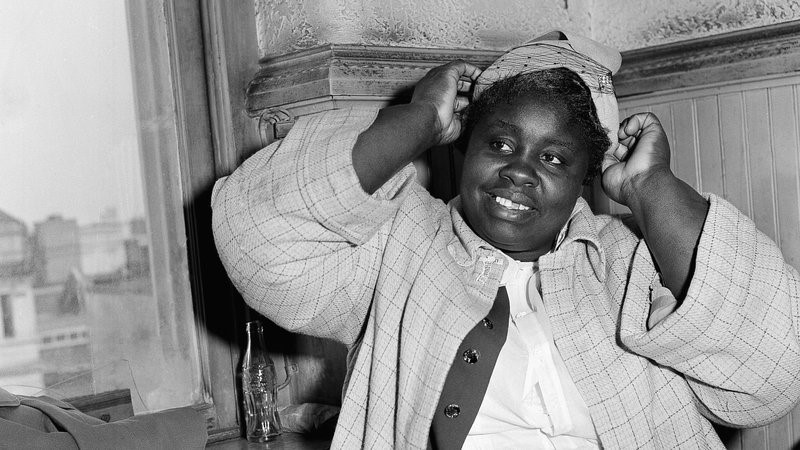
Georgia Gilmore Historical Marker
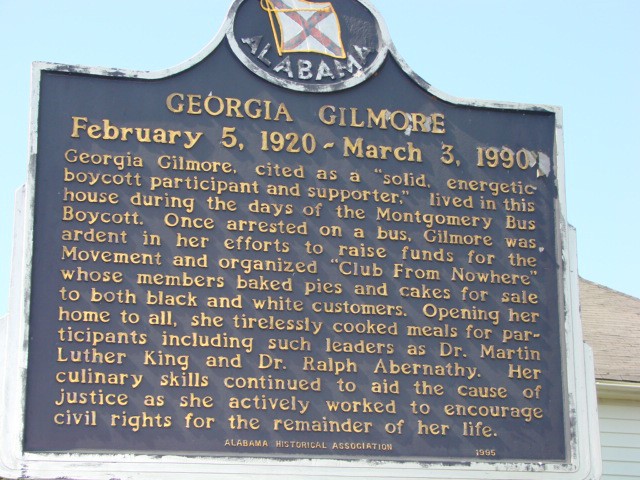
Site of Georgia Gilmore's original home in the 1950s.
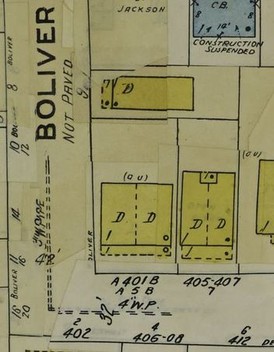
Georgia Gilmore seated at the kitchen table at her home in Montgomery, Alabama.
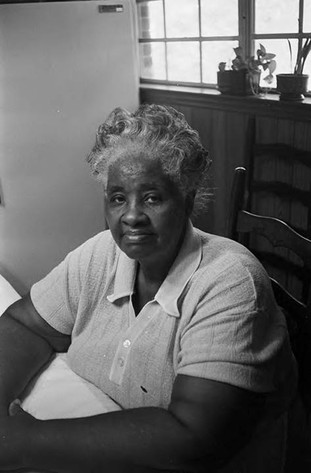
Large pot of food sitting on the stove inside Georgia Gilmore's house in Montgomery, Alabama.
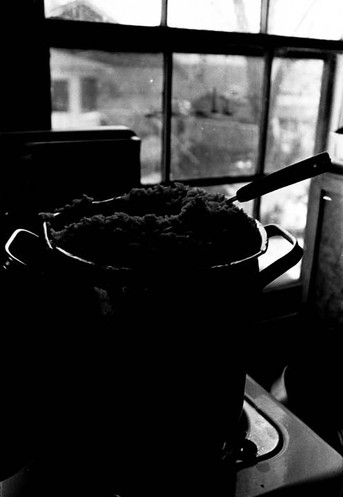
Known for her generosity, Georgia Gilmore was also a no nonsense woman.
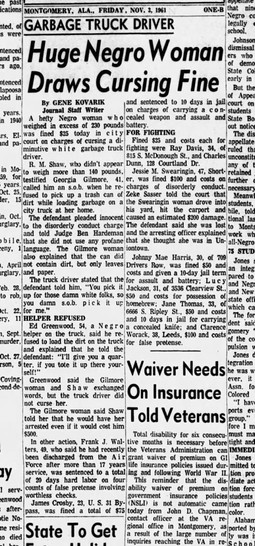
Home is Lunch Spot for Downtown Workers: Gilmore's Home Restaurant
%2C25Jun%201980.jpg)
"Chairs and the Cosmonauts" written by Georgia Gilmore
%2C16%20Aug%201962.jpg)
Desegregating City Parks in Montgomery
%2031%20December%201958..jpg)
Backstory and Context
Author-Uploaded Audio
Dr. Valda Montgomery, daughter of Dr. Richard Harris Jr., talks about Georgia Gilmore and her home in the 1950s and 1960s.
Text-to-speech Audio
A native of Montgomery County, Georgia Gilmore was born in February 1920 to Janie Gilmore. Mrs. Gilmore was a bold, fiery woman with a firm belief in the civil rights of Black Americans, and a knack for cooking. [1] Gilmore worked as a domestic worker, a midwife, and worked on the railroad. By the 1950s, she worked as a head cook at the National Lunch Company in downtown Montgomery. After the arrest of Rosa Parks, Gilmore joined other African American residents in the protest against the discriminatory treatment they received on city buses. As a talented cook and avid supporter of the local civil rights movement, she used her culinary skills to provide financial and social support. Gilmore and her friends started by selling chicken sandwiches to hungry meeting attendees at the mass meetings. Soon, the little group formed the Club from Nowhere. The women sold plates and pastries to financially support the MIA’s carpool system. Only Gilmore knew who made and bought the food and who donated money. The underground network of cooks went door-to-door selling sandwiches, pies, and cakes, and collecting donations. At each MIA mass meeting, Mrs. Gilmore dropped the money in the collection plate. Donations came from white as well as Black residents. The success of the club was so great that another group of supporters led by Inez Ricks created a rival organization called “The Friendly Club.” The two groups worked for the same cause and helped motivate each other by having a friendly rivalry to see who could raise more funds.[2]
Georgia Gilmore lost her job at the National Lunch Company when she testified against city buses after Dr. King and others were arrested in 1956. Rev. King recommended that she start a restaurant of her own and provided her with funds to expand her kitchen. Blacks and whites crowded around Gilmore's dining room and into her green-tiled kitchen while eating plates of chicken, macaroni and cheese, and other southern favorites.[3] King often walked from the Dexter Parsonage to Gilmore's restaurant for a plate of his favorites such as stuffed pork chops and potato salad. King often brought other civil rights activists including Robert Kennedy.Inside her home, Gilmore created a safe space for civil rights leaders to eat and talk.
Georgia Gilmore continued to serve as an activist in civil rights for the remainder of her life. In 1957, Gilmore sued the city of Montgomery after local police assaulted and arrested her son, Mark Gilmore when he took a shortcut through the whites-only Oak Park. The lawsuit brought an end to segregation in public recreational facilities in Montgomery. When the Freedom Riders arrived in Montgomery in 1961, a mob of white people attacked the unarmed college students. Four of those students sought refuge inside Gilmore’s house and stayed there until later that evening.[4]
Georgia Gilmore died in 1990. On the morning of her death, she was preparing food for the 25th anniversary of the Selma to Montgomery march. Her family served the food she cooked to those who came to mourn her passing.[5]
Sources
Nadasen, Premilla, Georgia Gilmore, Overlooked Activists of the Montgomery Bus Boycott, (2016) Beacon Brookside
[1] Valda Montgomery. Interview by Sylvia Marshall. 5 October 2021; Richard Bailey, Interview by Sylvia Marshall, 1 October 2021.
[2] John T. Edge, The Potlikker Papers: A Food History of the Modern South (New York: Penguin Books, 2017), 16;
[3] “King Helped Put Local Woman in Lunch Business”, Alabama Journal (Montgomery, Alabama), 4 April 1978; “State of Alabama v. M. L. King, Jr., Nos. 7399 and 9593,” Kinginstitute.stanford.edu, Stanford University the Martin Luther King, Jr. Research and Education Institute. https://kinginstitute.stanford.edu/encyclopedia/state-alabama-v-m-l-king-jr-nos-7399-and-9593; Frederick Brown, “ Mrs. Gilmore: ‘A Woman Who Put Her Foot In It’ for Freedom,” Alabama State University Archives and Special Collections.
[4] Betty Gilmore interview 2, interview by Dr. Howard Robinson, Dr. Shirley Jordan, and Stephanie Jordan, ASU Archives Oral History Collection, Alabama State University, 18 April 2006; “History of the Freedom Rides Museum,” Alabama Historical Commission, https://ahc.alabama.gov/FreedomRidesHistoryFacts.aspx.
[5] “Mrs. Gilmore: ‘A Woman Who Put Her Foot In It’ for Freedom”; Mark Gilmore. Interview by Dr. Howard Robinson and Shirley Townsend. ASU Archives Oral History Collection, Alabama State University, 25 March 2005.
Photo courtesy of the Associated Press.
Photo courtesy of Alabama Historical Society
1950 Sanborn Insurance Map for Montgomery, Alabama.
Alabama Department of Archives and History. Donated by Alabama Media Group. Photo by Frank Sikora, Birmingham News.
Alabama Department of Archives and History. Jim Peppler Collection.
"Huge Negro Woman Draws Cursing Fine" .Alabama Journal. 3 November 1961.
The Alabama Journal (Montgomery, AL), 25 June 1980.
The Montgomery Advetiser (Montgomery, AL),16 August 1962.
The Montgomery Advertiser (Montgomery, Alabama) 31 December 1958.
